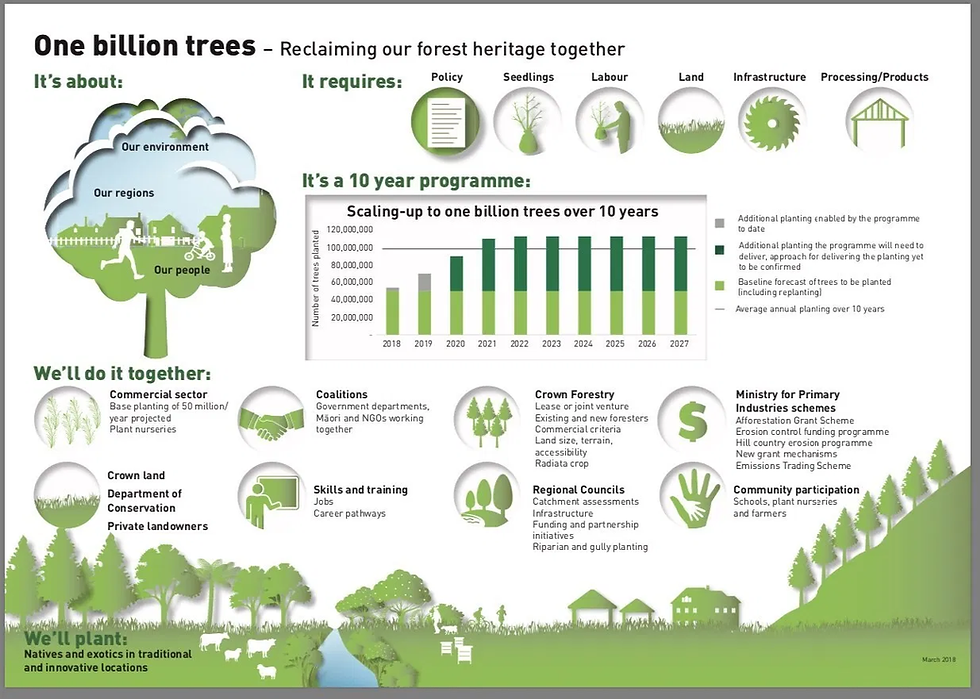Planting A Billion Trees
- Steven Erquiza
- Jan 18, 2020
- 3 min read

In Aotearoa New Zealand, they have a proverb: Toitū te ngahere, toitū te whenua, toitū te tangata. — If we look after the forest, if we look after the land, the land will look after us.
New Zealand is close to finalizing an initiative, which is the One Billion Trees Programme, launched in 2017. The aim is to see at least one billion trees planted over the next ten years. The vision is to transform New Zealand to improve the economic performance of their regions, the social and cultural outcomes for their people, and the quality of their environment. The government assigned an additional $240 million to the project, bringing its total budget to $485 million over the next three years, for landowners, organizations, and community groups to plant trees and to improve the way we grow and plant trees. If approved, the program would play a vital role in the country’s efforts to mitigate climate change. At current rates, we estimate commercial foresters will plant 500 million trees. They're offering incentives for the citizens of New Zealand to get involved in planting the other 500 million trees. The plan is to make it easier to plant the right tree in the right place for the right purpose. We want to see a broad range of exotic and native trees established for both permanent and plantation forests.
Right tree - They want to encourage both permanent, and plantation forests made up of exotic and native tree species. The program promotes the planting of native species to improve biodiversity.
Right place - We also want trees planted to be appropriate for the site and their intended use. To do this, we need to align tree planting with local land-use and planting priorities and strategies.
Right purpose - They want to make sure that planting these trees is precisely planned out and considers the long-term maintenance and end-use of the trees. Commercial viability for production forests and protection for permanent forests should be thought through before planting. We also want to make sure plantings take local social, environmental, cultural, and economic priorities into account.
Diversity of income for landowners; opportunities for Māori – the indigenous people of New Zealand – to maximize the potential of their land and resources; environmental issues like erosion and water quality addressed; native biodiversity; new innovative, high-value wood products developed; and our climate change commitments met. One way we will achieve this connection is through a strong focus on establishing native trees across the country. 80% of New Zealand was once covered in native forests, now. They only cover a little over a quarter of the country. When native forests, shrublands, and wetlands are lost, we lose the full range of benefits they provide.
Trees can fight climate change by pulling greenhouse gas emissions from the atmosphere. They also help to protect the land from some of the more devastating consequences of climate change like flooding and storms. That’s on top of the many other benefits of trees — cleaning the air, soil, and water, providing food and shelter, and much more. Jones, the forestry minister, said that the trees would help to rehabilitate degraded environments, help wildlife thrive, and provide around 1,000 jobs. Countries have to cut greenhouse emissions drastically. New Zealand currently has a run-of-the-mill emissions reductions target under the Paris climate agreement. The country is trying to lower 2005 emissions levels by 30% in 2030.
The 2050 proposal of getting to net-zero emissions is more ambitious. It would be an excellent complement to a billion new trees.
The initiative likes broad support, according to Stuff, and the government is considering public-private partnerships that would provide grants to people who have lands to plant trees on their properties. This approach to environmental rehabilitation is happening in other parts of the world, too. In Pakistan, newly elected Prime Minister Imran Khan announced a plan to plant 10 billion trees, and India has backed similarly ambitious projects.





Comments